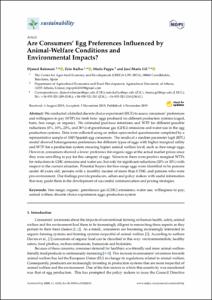Mostra el registre d'ítem simple
Are consumers’ egg preferences influenced by animal-welfare conditions and environmental impacts?
| dc.contributor.author | Rahmani, Djamel |
| dc.contributor.author | Kallas, Zein |
| dc.contributor.author | Pappa, Maria |
| dc.contributor.author | Gil Roig, José María |
| dc.contributor.other | Universitat Politècnica de Catalunya. Departament d'Enginyeria Agroalimentària i Biotecnologia |
| dc.date.accessioned | 2020-02-28T13:56:29Z |
| dc.date.available | 2020-02-28T13:56:29Z |
| dc.date.issued | 2019-11-06 |
| dc.identifier.citation | Rahmani, D. [et al.]. Are consumers’ egg preferences influenced by animal-welfare conditions and environmental impacts?. "Sustainability", 6 Novembre 2019, vol. 11, núm. 6218, p. 1-23. |
| dc.identifier.issn | 2071-1050 |
| dc.identifier.uri | http://hdl.handle.net/2117/178891 |
| dc.description.abstract | We conducted a labelled discrete choice experiment (DCE) to assess consumers’ preferences and willingness to pay (WTP) for fresh hens’ eggs produced via different production systems (caged, barn, free range, or organic). We estimated purchase intentions and WTP for different possible reductions (0%, 10%, 20%, and 30%) of greenhouse gas (GHG) emissions and water use in the egg production systems. Data were collected using an online open-ended questionnaire completed by a representative sample of 1045 Spanish egg consumers. The results of a random parameter logit (RPL) model showed heterogeneous preferences for different types of eggs with higher marginal utility and WTP for a production system ensuring higher animal welfare level, such as free-range eggs. However, consumers showed a lower preference for organic eggs at the actual market prices since they were unwilling to pay for this category of eggs. Moreover, there were positive marginal WTPs for reductions in GHG emissions and water use, but only for significant reductions (20% or 30%) with respect to the current situation. Potential buyers for free-range eggs were identified to be persons under 40 years old, persons with a monthly income of more than €1500, and persons who were pro-environment. Our findings provide producers, sellers and policy makers with useful information that may guide them in the development of successful communication and pricing strategies. |
| dc.format.extent | 23 p. |
| dc.language.iso | eng |
| dc.rights | Attribution-NonCommercial-ShareAlike 3.0 Spain |
| dc.rights.uri | http://creativecommons.org/licenses/by-nc-sa/3.0/es/ |
| dc.subject | Àrees temàtiques de la UPC::Enginyeria agroalimentària::Indústries agroalimentàries::Productes d'origen animal |
| dc.subject.lcsh | Consumers' preferences |
| dc.subject.other | Free range |
| dc.subject.other | organic |
| dc.subject.other | greenhouse gas (GHG) emissions |
| dc.subject.other | water use |
| dc.subject.other | willingness to pay |
| dc.subject.other | animal welfare |
| dc.subject.other | discrete choice experiment |
| dc.subject.other | eggs |
| dc.subject.other | production system |
| dc.subject.other | Agrotech |
| dc.title | Are consumers’ egg preferences influenced by animal-welfare conditions and environmental impacts? |
| dc.type | Article |
| dc.subject.lemac | Ous -- Indústria i comerç |
| dc.contributor.group | Universitat Politècnica de Catalunya. CREDA - Centre de Recerca en Economia i Desenvolupament Agroalimentari |
| dc.identifier.doi | 10.3390/su11226218 |
| dc.relation.publisherversion | https://www.mdpi.com/2071-1050/11/22/6218 |
| dc.rights.access | Open Access |
| local.identifier.drac | 26678208 |
| dc.description.version | Postprint (published version) |
| dc.relation.projectid | info:eu-repo/grantAgreement/EC/H2020/633531/EU/Adapting the feed, the animal and the feeding techniques to improve the efficiency and sustainability of monogastric livestock production systems/Feed-a-Gene |
| local.citation.author | Rahmani, D.; Kallas, Z.; Pappa, M.; Gil, J.M. |
| local.citation.publicationName | Sustainability |
| local.citation.volume | 11 |
| local.citation.number | 6218 |
| local.citation.startingPage | 1 |
| local.citation.endingPage | 23 |
Fitxers d'aquest items
Aquest ítem apareix a les col·leccions següents
-
Articles de revista [74]
-
Articles de revista [1.060]



